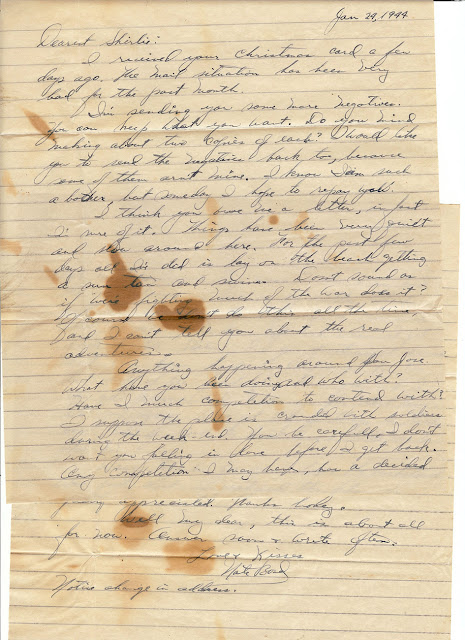Nathan J Bond was born 6 Feb 1917 in Ida Grove, Iowa. An
outstanding multi-sport athlete in high school and college, Nate enlisted in
the US Army in November of 1940 while he was still in college. He was assigned
to the Field Artillery Battery F out of the Vermillion South Dakota. This unit
was part of the 147th Battalion which was mobilized in late 1941 to head
out to Northern Australia.
According to an account from the South Dakota State Historical Society, Journey to Timor: South
Dakota National Guardsmen in the Dutch East Indies, 1942 by Robert G. Web, then Sgt. Nate Bond performed
some feats of courage while in the southeast Asian waters. (For the complete
chapter from this publication click here.)
"When the 147th and 148th Field Artillery regiments arrived
in Darwin, they found the military situation in the South Pacific discouraging.
In British Malaya, the Dutch East Indies, and the American Philippines,
Japanese forces were advancing at an alarming rate. To help strengthen Allied
defenses in the Darwin area, the two artillery units were assigned to the
Australian Army's tiny Northern Territory Forces. On 24 January, the Northern
Territory Forces became part of the newly created
American-British-Dutch-Australian (ABDA) Com- mand, the first Allied command of
the war. British general Sir Archibald Waveil headed the command, establishing
his headquarters at Batavia, Java, in the Dutch East Indies. Wavell's orders
were to hold the Malay Barrier, a hastily drawn Allied defense line that included
British Malaya, the islands of Sumatra, Java, and Timor in the Dutch East
Indies, and northern Australia. In addition, the command was to operate as far
beyond that line of defense as possible in order to check Japanese advances and
restore communications with the Philippine Islands.
"On 29 January, as part of the attempt to fulfill these
orders with the limited resources available, ABDA Command called upon the 147th
to furnish an officer and fifteen enlisted men for a special mission. Each man
was to be a volunteer and a strong swimmer. The individuals selected included
Sgt. Nathan Bond of Ida Grove, Iowa; … Except for Sergeant Bond, who belonged
to Battery F of Vermillion when the 147th mobilized in 1940, the non-South
Dakotans were either draftees or regular army enlistees assigned to the
regiment at Fort Ord in 1941
"… While the Peary (the ship Bond was on) stood
offshore. Burnside (officer in charge of the volunteer unit) and his men
hoisted the gasoline barrels, which had been lashed into rafts, overboard and
used the ship's lifeboats to tow them toward the beach. The scheme might have
worked in calm seas and daylight. Instead, the surf was high, and the night was
dark as pitch.
"As Private Meyer recalled: "We got toward those big
waves, and those barrels came right aboard. We either had to get out of there
or get crushed. We saw what happened to the other boat. We cut the barrels
loose but still couldn't get to shore—the waves were that big." Lieutenant
Burnside ordered the men, who were wearing life jackets, to jump into the sea
and make for the beach. "You know," remembered Meyer, "some of
the guys took their shoes off and everything, but I kept my gun on my side and
kept my shoes on. … While the original call for volunteers had stipulated that
all the men be good swimmers, three soldiers apparently had not been informed
of this requirement."' Pvt. Kenneth Wold, a non-swimmer, hesitated to go
over the side of the boat. Meyer remembered that Wold's eyes "were as big
as saucers." Sgt. Nathan Bond, who stood six feet, two inches tall,
weighed 225 pounds, and had been an outstanding athlete at the University of
South Dakota, took Wold into the water with him. Together, they rode the
breakers into shore."

Nathan J Bond would be promoted to Lieutenant before he left
the Army at the end of the war. He went back to school to get his teacher’s
certification and was a popular high school athletic coach for many years in
his home state of Iowa.
Sometime in 1941, Nate met Shirlie Montgomery on his way to Fort
Ord in Monterey California for training and ultimate deployment to SE Asia. As
Shirlie did with so many soldiers and sailors who stopped in San Jose during
WW2, she and Nate struck up a friendship and wrote each other often. Nate sent
her numerous photos (and a bunch of negatives for her to print) as well as some
Japanese “funny money” from the war.
A while back I put a number of letters and photographs from Nate
Bond for sale online. Tom Saluzzo of Arizona purchased a few
of lots from me and created a really nice display … he said he wanted to keep this
WW2 correspondence together. What a great idea … and he did a very fine job.
I want to thank Tom Saluzzo for sending me photos of his excellent display and for finding the article about Nate in the East Indies.















